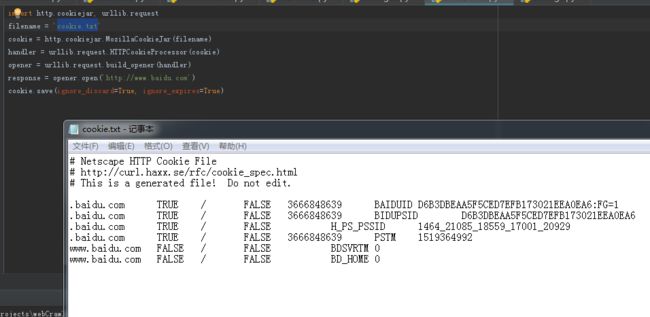python 3.x 爬虫基础
python 3.x 爬虫基础---http headers详解
python 3.x 爬虫基础---Urllib详解
python 3.x 爬虫基础---Requersts,BeautifulSoup4(bs4)
python 3.x 爬虫基础---正则表达式
前言
爬虫也了解了一段时间了希望在半个月的时间内结束它的学习,开启python的新大陆,今天大致总结一下爬虫基础相关的类库---Urllib。
Urllib
官方文档地址:https://docs.python.org/3/library/urllib.html
urllib提供了一系列用于操作URL的功能。
Python3中将python2.7的urllib和urllib2两个包合并成了一个urllib库,其主要包括一下模块:
urllib.request 请求模块
urllib.error 异常处理模块
urllib.parse url解析模块
urllib.robotparser robots.txt解析模块
urllib.request
urllib.request.urlopen
通过案例可以看出urlopen,会返回一个二进制的对象,对这个对象进行read()操作可以得到一个包含网页的二进制字符串,然后用decode()解码成一段html代码。
urlopen参数如下:
urllib.request.urlopen(url, data=None, [timeout, ]*, cafile=None, capath=None, cadefault=False, context=None)
常用参数:
url:访问的地址,一般不只是地址。
data:此参数为可选字段,特别要注意的是,如果选择,请求变为post传递方式,其中传递的参数需要转为bytes,如果是我们只需要通过 urllib.parse.urlencode 转换即可:
import urllib.parse import urllib.request data = bytes(urllib.parse.urlencode({'word': 'hello'}), encoding= 'utf8') response = urllib.request.urlopen('http://xxxxx', data=data) print(response.read().decode('utf-8'))
timeout:设置网站的访问超时时间
其他参数:
context 参数:它必须是 ssl.SSLContext 类型,用来指定 SSL 设置。
cafile 和 capath 两个参数:是指定CA证书和它的路径,这个在请求 HTTPS 链接时会有用。
cadefault 参数:现在已经弃用了,默认为 False
urlopen返回对象提供方法:
read() , readline() ,readlines() , fileno() , close() :对HTTPResponse类型数据进行操作。
info():返回HTTPMessage对象,表示远程服务器返回的头信息。
getcode():返回Http状态码。
geturl():返回请求的url。
import urllib.request response = urllib.request.urlopen('http://python.org/') print("查看 response 的返回类型:",type(response)) print("查看反应地址信息: ",response) print("查看头部信息1(http header):\n",response.info()) print("查看头部信息2(http header):\n",response.getheaders()) print("输出头部属性信息:",response.getheader("Server")) print("查看响应状态信息1(http status):\n",response.status) print("查看响应状态信息2(http status):\n",response.getcode()) print("查看响应 url 地址:\n",response.geturl()) page = response.read() print("输出网页源码:",page.decode('utf-8'))
urllib.request.Request
import urllib.request headers = {'Host': 'www.xicidaili.com', 'User-Agent': 'Mozilla/4.0 (compatible; MSIE 7.0; Windows NT 6.0)', 'Accept': r'application/json, text/javascript, */*; q=0.01', 'Referer': r'http://www.xicidaili.com/', } req = urllib.request.Request(r'http://www.xicidaili.com/nn/', headers=headers) response = urllib.request.urlopen(req) html = response.read().decode('utf-8') print(html)
通过代码我们可以看出urlopen不再是传递url了,而是一个 request。这样一来我们不带把请求独立成一个对象,而且能更加灵活方便的配置访问参数,这是爬虫http必不可少的一步。
Request参数如下:
urllib.request.Request(url, data=None, headers={}, origin_req_host=None, unverifiable=False, method=None)
常用参数:
url:访问的地址。
data:此参数为可选字段,其中传递的参数需要转为bytes,如果是字典我们只需要通过 urllib.parse.urlencode 转换即可:
headers:http相应headers传递的信息,构造方法:headers 参数传递,通过调用 Request 对象的 add_header() 方法来添加请求头。python 3.x 爬虫基础---http headers详解,可参考此文章。
其他参数:
origin_req_host :指的是请求方的 host 名称或者 IP 地址。
unverifiable :用来表明这个请求是否是无法验证的,默认是 False 。意思就是说用户没有足够权限来选择接收这个请求的结果。如果没有权限,这时 unverifiable 的值就是 True 。
method :用来指示请求使用的方法,比如 GET , POST , PUT 等
urllib.request.ProxyHandler(ip代理)
以上做些简单的demo是没有问题的,但是如果想让你的爬虫更加强大,那么 rulllib.request.ProxyHandler 设置代理你一定要知道,网站它会检测某一段时间某个IP 的访问次数,如果访问次数过多,它会禁止你的访问,所以这个时候需要通过设置代理来爬取数据
ef Proxy_read(proxy_list, user_agent_list, i): proxy_ip = proxy_list[i] print('当前代理ip:%s'%proxy_ip) user_agent = random.choice(user_agent_list) print('当前代理user_agent:%s'%user_agent) sleep_time = random.randint(1,3) print('等待时间:%s s' %sleep_time) time.sleep(sleep_time) print('开始获取') headers = {'User-Agent': user_agent,'Accept': r'application/json, text/javascript, */*; q=0.01', 'Referer': r'https://www.cnblogs.com' } proxy_support = request.ProxyHandler({'http':proxy_ip}) opener = request.build_opener(proxy_support) request.install_opener(opener) req = request.Request(r'https://www.cnblogs.com/kmonkeywyl/p/8409715.html',headers=headers) try: html = request.urlopen(req).read().decode('utf-8') except Exception as e: print('******打开失败!******') else: global count count +=1 print('OK!总计成功%s次!'%count)
以上代码是前段时间写的刷新页面的但是没有达到想要的效果,不过里面有用到 request.ProxyHandler({'http':proxy_ip}) 。其中 urllib.request.build_opener() 方法来利用这个处理器构建一个 Opener ,那么这个 Opener 在发送请求的时候就具备了认证功能了。 request.install_opener(opener) 方法打开链接,就可以完成认证了。
urllib.request.HTTPCookieProcessor(cookie操作)
网站中通过cookie进行判断权限是很常见的。那么我们可以通过 urllib.request.HTTPCookieProcessor(cookie) 来操作cookie。使用Cookie和使用代理IP一样,也需要创建一个自己的opener。在HTTP包中,提供了cookiejar模块,用于提供对Cookie的支持。 http.cookiejar功能强大,我们可以利用本模块的CookieJar类的对象来捕获cookie并在后续连接请求时重新发送,比如可以实现模拟登录功能。该模块主要的对象有CookieJar、FileCookieJar、MozillaCookieJar、LWPCookieJar。
获取cookie( CookieJar)
import http.cookiejar, urllib.request cookie = http.cookiejar.CookieJar() handler = urllib.request.HTTPCookieProcessor(cookie) opener = urllib.request.build_opener(handler) response = opener.open('http://www.baidu.com') for item in cookie: print(item.name+"="+item.value)
保存cookie(MozillaCookieJar)
filename = 'cookie.txt' cookie = http.cookiejar.MozillaCookieJar(filename) handler = urllib.request.HTTPCookieProcessor(cookie) opener = urllib.request.build_opener(handler) response = opener.open('http://www.baidu.com') cookie.save(ignore_discard=True, ignore_expires=True)
使用cookie
import http.cookiejar, urllib.request cookie = http.cookiejar.MozillaCookieJar() cookie.load('cookie.txt', ignore_discard=True, ignore_expires=True) handler = urllib.request.HTTPCookieProcessor(cookie) opener = urllib.request.build_opener(handler) response = opener.open('http://www.baidu.com') print(response.read().decode('utf-8'))
其中FileCookieJar、MozillaCookieJar、LWPCookieJar约为保存cookie信息,只是保存格式不同。我们在进行操作cookie时使用对应的格式即可。
urllib.error
用 try-except来捕捉异常,主要的错误方式就两种 URLError(错误信息)和HTTPError(错误编码).
try: data=urllib.request.urlopen(url) print(data.read().decode('utf-8')) except urllib.error.HTTPError as e: print(e.code) except urllib.error.URLError as e: print(e.reason)
urllib.parse
urllib.parse.urlparse
将对应的URL解析成六部分,并以元组的数据格式返回来。
import urllib.parse o = urllib.parse.urlparse('http://www.cnblogs.com/kmonkeywyl/') print(o)
参数
result = urlparse('url',scheme='https')解析协议 可以去掉http://
result = urlparse('url',scheme='http')
result = urlparse('url',allow_fragments=False) url带有查询参数
result = urlparse('url',allow_fragments=False) url不带有查询参数
urllib.parse.urlunparse
拼接url
from urllib.parse data = ['http','www.baidu.com','index.html','user','a=1','comment'] print(urllib.parse.urlunparse(data))
urllib.parse.urljoin
用来拼接url的方法 或者叫组合方法,url必须为一致站点,否则后面参数会覆盖前面的host
from urllib.parse import urljoin print(urljoin('http://www.baidu.com','FAQ.html')) print(urljoin('http://www.badiu.com','https://www.baidu.com/FAQ.html')) print(urljoin('http://www.baidu.com/about.html','http://www.baidu.com/FAQ.html')) print(urljoin('www.baidu.com#comment','?category=2'))
这个在这个就不过多的介绍了,有兴趣的可以去看资料。
作者:王延领
出处:http://wyl1924.cnblogs.com
本文版权归作者和博客园共有,欢迎转载,但未经作者同意必须保留此段声明,且在文章页面明显位置给出原文链接。





